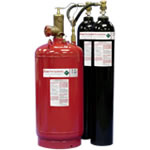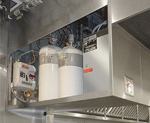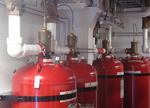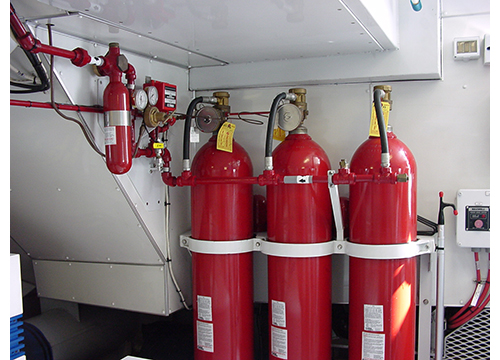What is special hazards fire protection?
Special hazards are defined by the critical nature of an operation or how easily the protected items or functions can be replaced. To determine if you need a special hazards fire suppression system, start by asking these questions. Can the items be replaced? Can you afford down time caused by fire damage or clean-up? Are there redundant systems? Can you still operate if this system goes down?"
If you answer no to these questions, then you need to look at fire protection not only for the structure of the building, but for the assets it contains. That is special hazards fire protection.
The special hazards family consists of five types of suppression systems. They include clean agent, foam, dry chemical, carbon dioxide and water mist systems.
What are clean agents?
Clean agents are gaseous fire suppressing agents. Because they suppress fire as gases, there is no damage to protected areas from the discharge and no residue to clean up. Thus, the term "clean" agents.
I heard these agents have been banned or are about to be banned from use. Is this true?
No. Starting in the 1960s, Halon 1301 was the principal agent used in clean agent extinguishing systems. However, Halon was found to have a high ozone depletion potential, so manufacture of Halon was banned in 1994. There is no ban on the use of Halon, however, and many Halon systems are still in service.
There are also no plans to ban Halon use at any time in the future. However, the EPA strongly recommends using one of the recently developed Halon alternatives. There are three commercially available Halon alternatives that are very effective at suppressing fire.
How do I know these new clean agents are safe?
The EPA phased out Halon production as part of the Clean Air Act of 1990. Another part of that Act was the Significant New Alternatives Policy (SNAP). Under SNAP, the EPA evaluated substitute chemicals and alternative technologies to ensure that they wouldn't cause greater damage to human health or the environment that the potential ozone depleters that were being replaced. Each of today's clean agents is SNAP approved.
Can people be exposed to clean agents?
Yes, part of the SNAP approval process includes testing for adverse effects in humans at recommended design concentrations. Each of today's clean agents is safe for humans and safe for the environment as well.
Halon 1301 is also safe for occupied areas at recommended design concentrations. However, some people consider carbon dioxide a clean agent as well because it shares the non-corrosive, no clean-up features. While carbon dioxide is a very effective fire suppressing agent, it is not safe for use in occupied areas.
What are the new clean agents?
At this time, the three commercially-available clean agents for total flooding applications are INERGEN, manufactured by Ansul, FM-200, manufactured by Great Lakes Chemical Company, and FE-13, manufactured by Dupont.
Which of the new clean agents is best?
Each of today's clean agents is SNAP-approved and very effective at suppressing fire. They do, however, have different features. The best way to decide which agent is right for you is to meet with an FSSA-member installer to go over the specific details of the hazard.
Must Halon fire suppression systems be dismantled?
No. You have no current legal obligation to remove Halon systems from service. Also, there is no federal legal requirement to remove systems from service by any specific date.
In order to minimize Halon emissions, EPA strongly encourages Halon users to explore non-ozone depleting alternatives. However, this has not been mandated in part not to put an undue burden on businesses.
What happens when a Halon system discharges?
First, you can legally recharge your system using recycled Halon or Halon produced before the ban on manufacturing. Recycled Halon is still readily available, although somewhat costly.
Again, EPA strongly encourages switching to a non-ozone-depleting agent. Unfortunately, none of the alternatives are drop-in replacements for Halon, so that is a costly proposition. If you should have a system discharge. This may be the time to weigh the cost of conversion against the cost of recharging the Halon system.
Where can recycled Halon be purchased?
In some cases, you can purchase recycled Halon from a fire protection equipment distributor. You can also purchase Halon directly from other owners who are decommissioning their systems. Remember, of course, that EPA requires appropriate training of those who will be handling the Halon.
You can also use the Halon Recycling Corporation. The HRC is a non-profit information clearinghouse established to assist sellers wishing to dispose of Halon in a responsible manner and to help buyers with critical uses locate supplies of Halon 1301 and 1211 for recharging their existing systems.
The HRC was established by members of the fire protection community and the Halon Alternatives Research Corporation, an industry consortium that promotes the research, development and use of alternatives to Halon for fire protection.
Can Halon be Imported?
It is legal under the Montreal Protocol and the U.S. Clean Air Act to import recycled Halon, that is, Halon that has been recovered from a fire suppression system. Each individual shipment of recycled Halon requires prior EPA approval. Approved imports that enter the U.S. must be reported to the EPA on a quarterly basis.
Newly produced Halon or Halon never installed in a fire suppression system may not be imported into the U.S.
Also, the IRS imposes a tax on certain ozone depleting chemicals.
If you choose to import Halon, know your source. Manufacturing standards in other countries are not always the same as in the U.S. and may affect the purity of the agent. There have been some problems with imported Halon containing water, causing the cylinders to rust from the inside.
What federal laws pertain to Halon?
EPA's final rule on Halon was published in March of 1998. It sought to ensure environmental benefits by requiring a set of practices already widely adhered to, that would minimize unnecessary releases of halons.
First, the rule banned creating blends of halons on the grounds that the infrastructure to recycle and reuse such blends isn't generally available and that growing stocks of non-recyclable Halon blends would pose a significant environmental risk.
Next, the rule prohibited the venting or intentional release of halons during most technician training exercises or during the testing, repair or disposal of Halon containing equipment.
The rule also requires that technicians who work with Halon-containing equipment be trained about Halon emission reductions.
Finally, the rule requires that halons and Halon-containing equipment be properly disposed of. The only permissible means of disposing of these items, aside from destruction, are by recovering the Halon with minimal losses to the atmosphere and by recycling it using facilities that operate in accordance with NFPA 10 and 12A
Sources for this training would include NICET, manufacturers' technical training programs and the Fire Suppression Systems Association. If local licensing requirements exist, that license should be sufficient to constitute appropriate training.
Are there any exemptions?
In recognition of the special needs of certain critical halon applications, the rule provided for some exemptions. For example, the release of halons during the testing of fire extinguishing systems or equipment is exempted if four criteria are met:
First, systems or equipment using suitable alternative agents aren't available.
Next, system or equipment testing requiring the release of the agent is essential to demonstrate system or equipment functionality.
Third, system failure would pose great risk to human safety or the environment.
Finally, a simulant agent can't be used for testing purposes.
How must the system be maintained?
EPA's final rule makes it clear that the owner of Halon-containing equipment is responsible for proper maintenance in accordance with NFPA standards. NFPA 12A, which pertains to Halon 1301 fire extinguishing systems, requires that, at least semi-annually, all systems be thoroughly inspected, tested and documented for proper operation by trained and competent personnel.
The standard goes on to say that agent quantity and pressure of refillable containers must be checked. If a container shows a loss in net weight of more than five percent, or a loss of pressure of more than 10 percent, it must be refilled or replaced. All Halon removed from these containers during service or maintenance must be collected for recycling.
According to D.O.T., Halon 1301 cylinders must be retested every five years if the cylinder has discharged. If the cylinder has never discharged, a visual inspection will suffice.
Maintenance must also include a visual inspection of all system components as well as the enclosure being protected. If the visual inspections turn up anything questionable, testing is required.
Finally, all maintenance and testing must be performed by personnel trained regarding Halon safety issues. Personnel working in a Halon-protected enclosure must also be trained on Halon safety. The owner of the system should keep a documented report of each inspection along with recommendations.
How Can I Dispose of Halon?
When it's time to dispose of your Halon, you have five options.
You can make it available to critical users through the Halon Recycling Corporation.
You can donate it to the Department of Defense Ozone Depleting Substances Reserve. You can return it to your distributor for resale.
You can send it to a Halon recycler.
If you have a very small amount of Halon 1301, or if you have Halon 1211 or 2402, Friends of the Earth can help you locate a regional organization that will take your Halon as a service.
Remember, Halon must be disposed of in accordance with EPA regulations.



